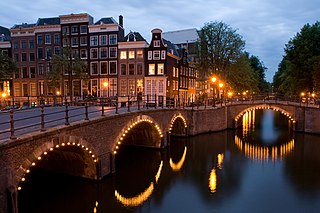
The Weather Underground Organization (WUO), commonly known as the Weather Underground, was a radical left militant organization active in the late 1960s and 1970s, founded on the Ann Arbor campus of the University of Michigan. It was originally called Weatherman and later became known colloquially as the Weathermen. The WUO organized in 1969 as a faction of Students for a Democratic Society (SDS) largely composed of the national office leadership of SDS and their supporters. Beginning in 1974, the organization's express political goal was to create a revolutionary party to overthrow what it viewed as American imperialism.

The City Loop is a mostly-underground and partly surface-level subway and rail system in the central business district (CBD) of Melbourne, Victoria, Australia.

The Amsterdam Metro is a rapid transit system serving Amsterdam, Netherlands and extending to the surrounding municipalities of Diemen and Ouder-Amstel. Until 2019 it also served the municipality of Amstelveen but this route has been closed for conversion into a tram line. The network is owned by the City of Amsterdam and operated by municipal public transport company Gemeentelijk Vervoerbedrijf (GVB) which also operates trams, free ferries and local buses.

The Oslo Metro is the rapid transit system of Oslo, Norway, operated by Sporveien T-banen on contract from the transit authority Ruter. The network consists of five lines that all run through the city centre, with a total length of 85 kilometres (53 mi), serving 101 stations of which 17 are underground or indoors. In addition to serving 14 out of the 15 boroughs of Oslo, two lines run to Kolsås and Østerås, in the neighboring municipality of Bærum. In 2016, the system had an annual ridership of 118 million.

Many highway revolts took place in developed countries during the 1960s and 1970s, in response to plans for the construction of new freeways, a significant number of which were abandoned or significantly scaled back due to widespread public opposition, especially of those whose neighborhoods would be disrupted or displaced by the proposed freeways, and due to various other negative effects that freeways are considered to have.
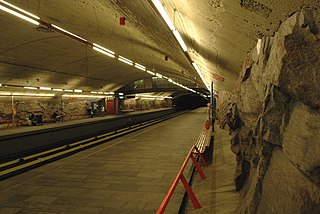
The Grorud Line is a 13.0-kilometer long (8.1 mi) line on the Oslo Metro between Tøyen and Vestli in Oslo, Norway. Built as a mix of underground, at ground level and as an elevated line, it runs through the northern part of Groruddalen, serving such neighborhoods as Grorud, Romsås and Stovner. Line 5 runs along the entire line four times per hour. Line 4 runs between Vestli and Økern before branching off on the Løren Line to get onto the Ring Line. With 40,000 daily riders, the Grorud Line is the busiest branch of the metro.

The Lambertseter Line is a 5.9-kilometer (3.7 mi) line on the Oslo Metro which runs from Brynseng to Bergkrystallen. It further shares track with the Østensjø Line along the 2.5-kilometer (1.6 mi) section from Tøyen to Brynseng. The line runs through a primary residential area of Nordstrand, serving neighborhoods such as Manglerud, Ryen and Lambertseter. The line is served by Line 4 of the metro, which runs every fifteen minutes. This is supplemented by Line 1 that is extended to Bergkrystallen between 6:30 and 19 on weekdays, giving a combined frequency of eight trains per hour.

The Chennai Metro is a rapid transit system serving the city of Chennai, Tamil Nadu, India. The system commenced service in 2015 after partially opening the first phase of the project. The network consists of two colour-coded lines covering a length of 45 kilometres (28 mi). It is the third largest metro system in India after Delhi Metro and Hyderabad Metro. The Chennai Metro Rail Limited (CMRL), a joint venture between Government of India and the Government of Tamil Nadu built and operates the Chennai Metro. The system has a mix of underground and elevated stations and uses standard gauge. The services operate daily between 4:30 and 23:00 with a varying frequency of 10 to 20 minutes. As of August 2019, about 111,000 people use the service on a daily basis. There are 42 trains with four coaches each, making a total of 168 coaches, operating in the first phase.
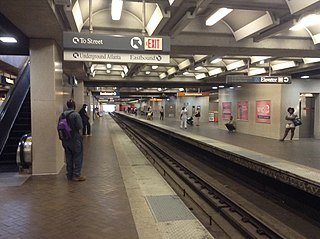
Five Points is a metro station of the Metropolitan Atlanta Rapid Transit Authority (MARTA) rail system in Atlanta, Georgia. It is the transfer point for all rail lines and serves as the main transportation hub for MARTA. It provides access to Station Soccer, the Five Points Business District, Underground Atlanta, City Hall, the Richard B. Russell Federal Building, Cobb Community Transit, Gwinnett County Transit, GRTA Xpress Transit, and the tourism heart of Downtown Atlanta. It provides connecting bus service to Zoo Atlanta, Grant Park, Atlanta University Center, East Atlanta Village, Martin Luther King, Jr., National Historic Site, Carter Center, Atlanta City Hall, South Dekalb Mall and Fulton County Government Center.

The Istanbul Metro is a rapid transit railway network that serves the city of Istanbul, Turkey. It is operated by Metro Istanbul, a public enterprise, controlled by the Istanbul Metropolitan Municipality. The oldest section of the metro is M1 line, which opened in 1989; it now includes 89 stations in service, with 64 more under construction.

The Jodenbreestraat is a street in the centre of Amsterdam, which connects the Sint Antoniesluis sluice gates to the Mr. Visserplein traffic circle. North of the sluice gates, the street continues on to Nieuwmarkt square as the Sint Antoniesbreestraat. The Mozes en Aäronkerk church stands at the southern end of the street. Directly behind the Jodenbreestraat is Waterlooplein square with its daily flea market.
Transportation within the city of Amsterdam is characterised by bicycles and public transportation. Large freeways only exist around the city, terminating at the A10 Ringroad. Navigating by car through the city centre is discouraged, with the government sponsoring initiatives to reduce car usage.
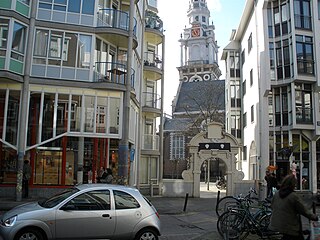
The Sint Antoniesbreestraat is a street in the centre of Amsterdam in the Netherlands. The street runs south from Nieuwmarkt square to the Sint Antoniesluis sluice gates, where it continues as the Jodenbreestraat. The Sint Antoniesbreestraat is primarily a shopping street with a variety of specialty shops. At the corner of Sint Antoniesbreestraat and Hoogstraat is an entry to the Nieuwmarkt stop of the Amsterdam Metro system.

Rapid transit or mass rapid transit (MRT), also known as heavy rail, metro, subway, tube, U-Bahn or underground, is a type of high-capacity public transport generally found in urban areas. Unlike buses or trams, rapid transit systems are electric railways that operate on an exclusive right-of-way, which cannot be accessed by pedestrians or other vehicles of any sort, and which is often grade separated in tunnels or on elevated railways.
The following is a timeline of the history of the municipality of Amsterdam, Netherlands.
The Aqua Line of the Mumbai Metro, also known as Line 3 or the Colaba–Bandra-SEEPZ line, is a part of the metro system for the city of Mumbai, India of which construction has been initiated. When completed, the 33.5-km long line will be the first underground metro line in Mumbai. The metro line will connect Cuffe Parade business district in the extreme south of the city to SEEPZ in the north-central with 26 underground and one at-grade station. The track width is standard gauge. The cost of this corridor is estimated at ₹30,000 crore (US$4.3 billion). Line 3 is expected to reduce road congestion, besides reducing the load on the Western Line between Bandra and Churchgate.

The Vondelstraat Riots were violent disturbances on Vondelstraat in Amsterdam, the Netherlands between squatters and the state in March 1980. It also involved the deployment of military tanks on the streets for the first time since World War II, and was one of the most serious disturbances involving squatters in the country.
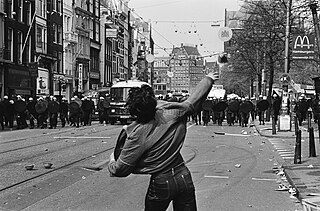
The Amsterdam coronation riots refers to major violence and rioting in Amsterdam, the Netherlands on the day of the accession of Queen Beatrix, 30 April 1980. It was the biggest episode of such disturbances in the country since the end of World War II and the most significant event of the Dutch squatters' movement (Krakersrellen).



